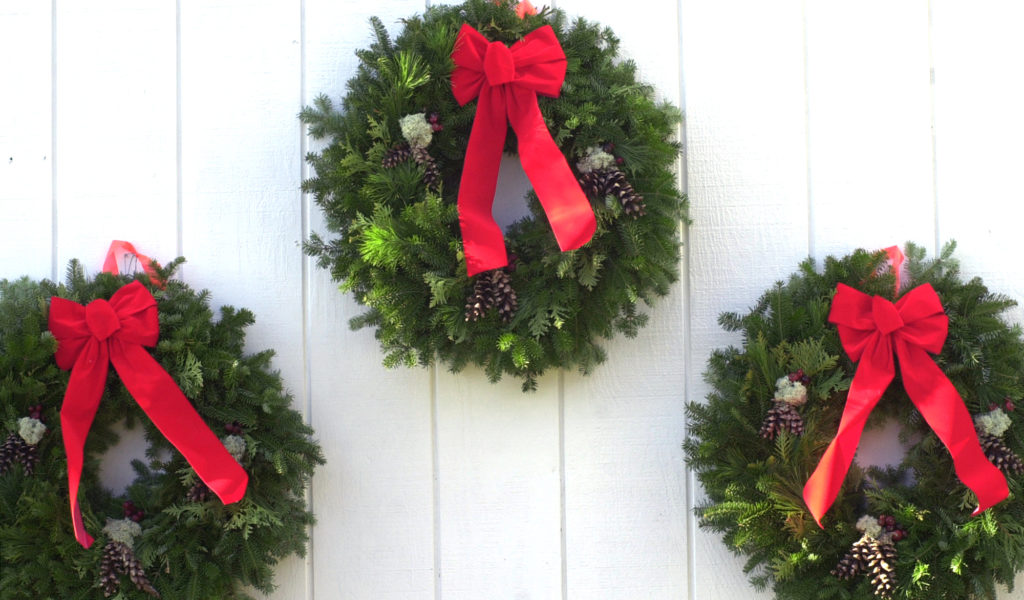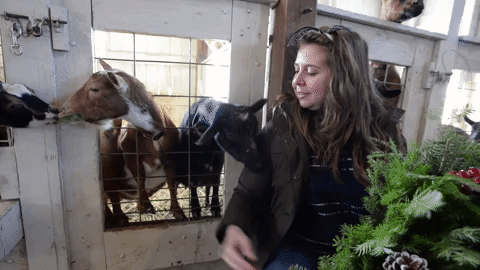I tried to make a wreath. Here’s how it went.
I struggle to get into the holiday spirit. Christmas music gives me a migraine, picking out presents makes me anxious and — let’s be honest — gingerbread houses are a waste of (frankly, mediocre) cookies.
Since I’ve moved to Maine, though, the ever-present evergreens and the magic of freshly fallen snow have seeped into my soul. I find myself Christmas-curious. I’m not about to start belting Mariah Carey and blanketing my house with wall-to-wall twinkle lights, but I wanted to find a way to celebrate my way: by getting in touch with the wonderful, wintery natural world, and making something to symbolize the joy of the holidays — family, coming together and taking a moment to appreciate what matters — with my own two hands.
So, I decided to make a wreath.
Though wreaths have been used throughout history for various ceremonial purposes, the holiday wreath as we know it today can be traced back to the pagan holiday of Yule. The 12-day ancient Germanic and Scandanavian festival celebrated the winter solstice, the shortest day of the year. Revelers constructed wreaths to signify nature and the promise of spring, and adorned them with lit candles to symbolize the return of warmth and sunlight.
Holiday wreaths were adopted by Christians in the early 16th century, as the practice of bringing evergreen trees indoors around the Christmas season began to catch on amongst eastern and northern Europeans. The trees were pruned into the shape of a triangle to represent the Trinity — Catholic legend even says that Saint Boniface, a monk from England, used the three points of an evergreen tree to explain the concept of God the Father, Son and Holy Ghost back in the seventh century — and the clippings were woven into wreaths.
Upcycling in one of its earliest forms — how could I resist?

These early wreaths were known as Advent wreaths and were rife with their own symbolism. Evergreens represent eternal life because the trees were able to survive harsh winters. Wreaths were adorned with red berries and thorny holly oak leaves to signify the crown of thorns worn by Jesus and the drops of blood it drew. Advent wreaths also held four candles that symbolize different components of the coming and light of Christ. Sometimes, a fifth, white candle was added to the center of the wreath — the Christ candle — and lit on Christmas Eve.
I found the symbolism of early advent wreaths is a little eerie, but today, wreaths are hung on a door or a window primarily is a decoration and symbolic invitation to the spirit of Christmas to enter the home and bring luck for the new year.
Maybe if I make a wreath, I thought, it will bring a little spirit — Christmas, Pagan or otherwise — to my holiday season.
Learning to try
First, I needed to find someone to teach my proper wreath-making technique. I received a notification that Treworgy Family Orchards (where I once got lost in a corn maze) hosts wreath making workshops throughout the end of November and beginning of December. I asked if I could attend and, soon enough, I found myself in a huddling for warmth in their Levant offices, waiting for my wreath making workshop’s time slot as the wind raged outside.
Ginny Nute, Treworgy’s director of farm camp and education, taught the workshop. She told me that she has been making wreaths for years — she resisted learning how growing up, but developed a bond with an elderly neighbor as an adult who showed her the wreath-making ropes (now that’s a Christmas movie that I would watch). She started the workshops at Treworgy a few years ago as an addition to their holiday offerings.

Ginny showed the other workshop attendees and me the wreath-making materials: a crimped metal hoop, wire, clippers, wire cutters and piles of balsam fir tips. She explained that Treworgy will send fir tippers out to gather from the forest on their property, but since each wreath requires between seven and ten pounds of clippings, they will also pay for people to bring bundles of fir tips from their own properties to supply the popular workshop. The wreath ring came from a Christmas speciality store called Kelco Industries, where Treworgy purchases many different Christmas-related supplies for their cut-your-own Christmas tree shop as well.
Ginny said that the wreath would be comprised of a series of tip “bundles,” each no bigger than the hoop itself to keep the wreath from growing too heavy and unwieldy, wrapped tightly to the wreath ring with wire. She showed the other workshop attendees and me how the underside of the branches are lighter, and should be facing inwards when tying both front and back bundles so only the rich, dark evergreen color is on display. To demonstrate, she quickly clipped and tied a few bundles on to her own wreath ring.
I was intimidated by the ease and confidence with which Ginny was forming her wreath, but I brushed my feelings aside: it was time for me to make a wreath.
A trying experience
Adhering the first few bundles to my wreath ring was awkward. For some reason, I couldn’t quite figure out how to wrap the wire around my wreath ring without getting myself tangled up inside. I observed master Ginny (luckily, she was right next to me) and eventually figured it out: keep the hoop close to the table (this also helps when the wreath accumulates tips and mass) and only unspool as much of the wire as you need at the time to keep it from coiling around everything in sight.

I got into the wreath-making groove. I had a few mishaps — some tips weren’t tied tight enough, and I dropped my spool of wire a few times — but I found the rhythm of making my wreath methodical and relaxing.
Discerning between the different “sides” of the tips was challenging for me, though, especially for younger branches that had little variation in color. Despite my best efforts, I am sure I put a few tips on backward. That, I decided, personalizes the wreath; it’s variegated as an aesthetic choice.
The process was also messier than I expected. My hands were covered in sap and needles, and my fingers felt frozen because the balsam tips came from outside, some even with snow still on them. But it was a satisfying kind of a mess — a holly jolly Christ-mess, if you will.
Finishing the wreath is the hardest part. The final stretch of the wreath ring is hidden under brushy tips, and you have to be careful not to trap them under the wire you are wrapping. Once the final bundle was in, though, Ginny helped me tie off the end and make a hanger.
Finally, I got to decorate my masterpiece. I headed out to the barn, where goats, chickens and a wide array of bows, berries and pinecones awaited me. I kept it simple: single plaid bow on the bottom, plus a few bright red fake berries and pinecones dusted with “snow,” peppered tastefully and asymmetrically around my wreath.

Surrounded by cute farm critters and smelling of fir, I finally found a holiday tradition to call my own.
My tried-and-true takeaways
Once you get into the groove of making a wreath, the process is fun and relaxing. Though it does require some specialized items (namely, the wreath ring), but it generally requires few materials that are easy to obtain and use.
The most challenging part, I think, would be gathering enough balsam fir tips for a full, hearty wreath. I’ll have to try that next year.
